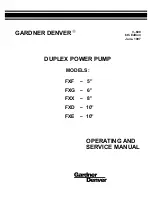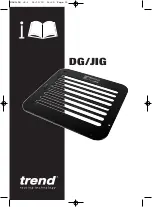
12
| English
Vibration total values a
h
(triax vector sum) and uncertainty K
determined according to
EN 62841‑2‑8
:
a
h
=
5
m/s
2
, K =
1.5
m/s
2
.
The vibration level and noise emission value given in these
instructions have been measured in accordance with a
standardised measuring procedure and may be used to com-
pare power tools. They may also be used for a preliminary
estimation of vibration and noise emissions.
The stated vibration level and noise emission value repres-
ent the main applications of the power tool. However, if the
power tool is used for other applications, with different ap-
plication tools or is poorly maintained, the vibration level
and noise emission value may differ. This may significantly
increase the vibration and noise emissions over the total
working period.
To estimate vibration and noise emissions accurately, the
times when the tool is switched off or when it is running but
not actually being used should also be taken into account.
This may significantly reduce vibration and noise emissions
over the total working period.
Implement additional safety measures to protect the oper-
ator from the effects of vibration, such as servicing the
power tool and application tools, keeping their hands warm,
and organising workflows correctly.
Assembly
Charging the Battery
u
Use only the chargers listed in the technical data.
Only
these chargers are matched to the lithium-ion battery of
your power tool.
Note:
The battery is supplied partially charged. To ensure
full battery capacity, fully charge the battery in the charger
before using your power tool for the first time.
The lithium-ion battery can be charged at any time without
reducing its service life. Interrupting the charging process
does not damage the battery.
The lithium-ion battery is protected against deep discharge
by the "Electronic Cell Protection (ECP)". When the battery
is discharged, the power tool is switched off by means of a
protective circuit: The application tool no longer rotates.
u
Do not continue to press the On/Off switch after the
power tool has automatically switched off.
The battery
can be damaged.
Removing the battery
The battery
(1)
is equipped with two locking levels to pre-
vent the battery from falling out if the battery release but-
ton
(2)
is pressed unintentionally. As long as the battery is
inserted in the power tool, it is held in position by means of a
spring.
To remove the battery
(1)
, press the battery release but-
ton
(2)
and pull the battery out of the power tool.
Do not use
force to do this.
Battery charge indicator
The green LEDs on the battery charge indicator indicate the
state of charge of the battery. For safety reasons, it is only
possible to check the state of charge when the power tool is
not in operation.
Press the button for the battery charge indicator or
to
show the state of charge. This is also possible when the bat-
tery is removed.
If no LED lights up after pressing the button for the battery
charge indicator, then the battery is defective and must be
replaced.
Battery model GBA 18V...
LEDs
Capacity
3× continuous green light
60−100 %
2× continuous green light
30−60 %
1× continuous green light
5−30 %
1× flashing green light
0−5 %
Battery model ProCORE18V...
LEDs
Capacity
5× continuous green light
80−100 %
4× continuous green light
60−80 %
3× continuous green light
40−60 %
2× continuous green light
20−40 %
1× continuous green light
5−20 %
1× flashing green light
0−5 %
Operation
Starting Operation
Inserting the Battery
Push the charged battery
(1)
into the base of the power tool
until the battery is securely locked.
Switching On and Off
To
switch on
the power tool, slide the on/off switch
(3)
for-
wards so that
I
appears on the switch.
To
switch off
the power tool, slide the on/off switch
(3)
backwards so that
0
appears on the switch.
Changing the cutting direction
To change the cutting direction, the die holder
(7)
can be
turned to three positions, each offset by 90°. Cutting to-
wards the rear (towards the housing of the machine) is not
possible.
1 609 92A 501 | (02.12.2019)
Bosch Power Tools













































